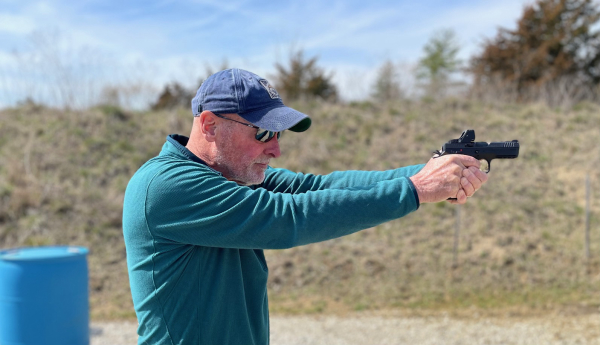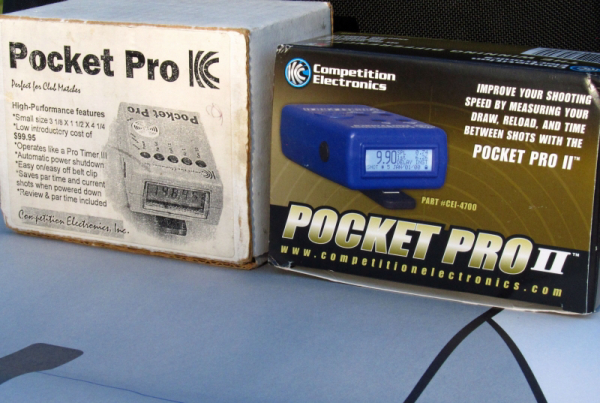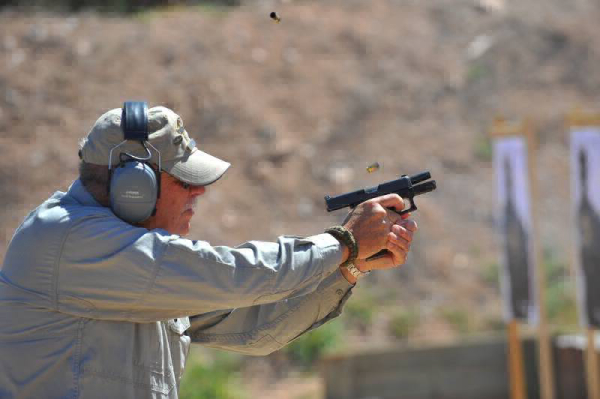
A few years ago, I was teaching a combative pistol course to a group of law enforcement professionals and legally armed citizens. Although many instructors call basic handgun skills “fundamentals,” I prefer to use the word “essentials” since shooters must have these skills to use a handgun for their personal security.
I began this course with several “time in” drills I use to evaluate a student’s level of skill. My time in drills were fired at 20 feet (7 yards is fine) into a 6 x 9-inch rectangle as follows:
• One shot from the ready/muzzle diversion position of their choice in one second;
• One shot from the holster in two seconds;
• One shot, emergency reload, one shot in 3.25 seconds;
• Four rounds from ready/muzzle diversion in two seconds
I look for proper grip, trigger manipulation, recoil control, aggressive body position and general weapon handling ability. Basically, I look to see if the students know what they are doing or are they hesitant? Bottom line: Do they look as if they know how to “run their gun” or will they be a safety concern?
During this class, I had a student, while completing these drills, draw his firearm and shoot in an almost slow-motion manner—it took him over three seconds to get a single hit on target. So, I asked him to do it again, assuming he’d step up his pace on his second run, but he performed the drill at the same speed. When I asked about the speed of his draw stroke, he said, “I have found that it leads to a higher level of success when I shoot the "XYZ Drill." I have been working toward a faster time on it.”
I then asked him what other skills he practices regularly and he told me “None. I feel this drill is an excellent compilation of what I will need in a gunfight - it covers it all.” After a brief pause I said, “Except someone shooting back at you. When this happens, you will die.”

It was obvious, from the look on his face, he didn’t know what to say. I found this mentality in my classes more often than I’d like. Few people have experienced armed conflict, which is a good thing, so they confuse their training course or competition experience with combat. As much as we may want them to be, they’re not the same. Although both involve shooting guns and stress, the stress level isn’t equal in severity. A gunfight is more DURESS, an unbelievable amount of pressure. Success must be assured because if you fail you are either injured or dead, not just further down in the standings.
I’ve competed in scholastic and collegiate sports as well as competitive shooting at various levels (PPC, USPSA and IDPA) and I’ve had someone try to take my life —the stress/duress isn’t the same. The activities themselves aren’t the same either. If there are rules, it’s a sport/competition. There are no rules in a gunfight—so if you’re not cheating, you’re not trying hard enough to win. This is an obvious difference in your state of mind as compared to sport/competition. Now, I am not saying don’t compete. You should; life is too short, do what you enjoy. What I am saying is understand the difference.
Armed conflict should be avoided at all costs because you always run the risk of losing, no matter how well trained and prepared you are. Worse yet, many people believe they’re better trained and prepared than they really are. People “suffering” from this condition enter a fight with a serious disadvantage they don’t know they have. Confusing proficiency in a particular drill with combat preparation is a symptom of this affliction. Shooting standards and drills during training are an excellent way to build and maintain essential skills, but they aren’t a solution to preparation. A standard is “something established for use as a comparison in measuring quality” while a drill is “systematic training, practice or teaching by repeated exercise.” A skill is “an ability or proficiency; an art, craft, etc. using the hands or body.”
To my way of thinking, a skill is “a physical activity in which you have a high expectation of success on the first try.” I don’t know how many times a student has told me “I have a one second concealed draw!”
“Please show me.” Their response is “Well, I have to warm up first.” Sorry, having accomplished something is not the same as a skill. In addition, I think a true skill should be repeatable, something like 8 out of 10 attempts.
As they relate to the combative application of a firearm, required skills (essentials) are those physical activities needed to shoot well enough to save your own life and they need to be adaptive. A drill should be used to reinforce these physical activities and standards are used to measure performance as training progresses. None of these are a gunfight in themselves and to confuse them as some type of equivalent is unwise — and potentially deadly. Standards and drills should be viewed as vehicles toward preparation, as should training and competition, but neither should be confused with being prepared to act. This is a long process that is undertaken at multiple levels. It cannot be completed in a weekend class.

With this understood, drills and standards are useful tools and most every student of combative weapon craft is always looking for new ones in which to test their skills. One of my favorite drills, and a good example of a skill drill, is the classic El Presidente, as pioneered by the late Jeff Cooper. This drill is still used in classes at Gunsite and I like it because it tests a number of essential skills in a short exercise. From 10 yards, 12 rounds are fired at three targets one meter apart. The targets should represent the high chest region.
Col. Cooper used 10-inch circles while Gunsite currently uses an 8-inch circle. I use a 6 x 10 rectangle but 8-x- 11 sheets of paper works fine, too. Use something that is representative of the high chest. Full size human silhouettes will only result in false confidence. With your back to the targets, turn and draw from your holster and shoot two rounds at each target. Perform an in- battery reload (some use an emergency reload, thinking this is more realistic which is fine) and then fire two more rounds at each target. Try to get all hits in at 10 seconds or less. A great drill but with a word of caution, don't confuse this drill with engaging with actual multiple threats. The circumstance from which this drill was created resulted in the death of the single shooter. Nuff said...
Hopefully, the difference between drills and standards is apparent. Both are designed to build and test skills, but they should never be confused with what will occur in armed conflict. In a gunfight expect nothing, plan on everything potentially failing and be prepared to move on to a contingency plan. The person who will win in armed conflict is someone who can adapt their essential skills to the situation they face. This isn’t something that can be taught in a drill or standard shoot but only by a well-developed and thorough training program.
— Dave Spaulding